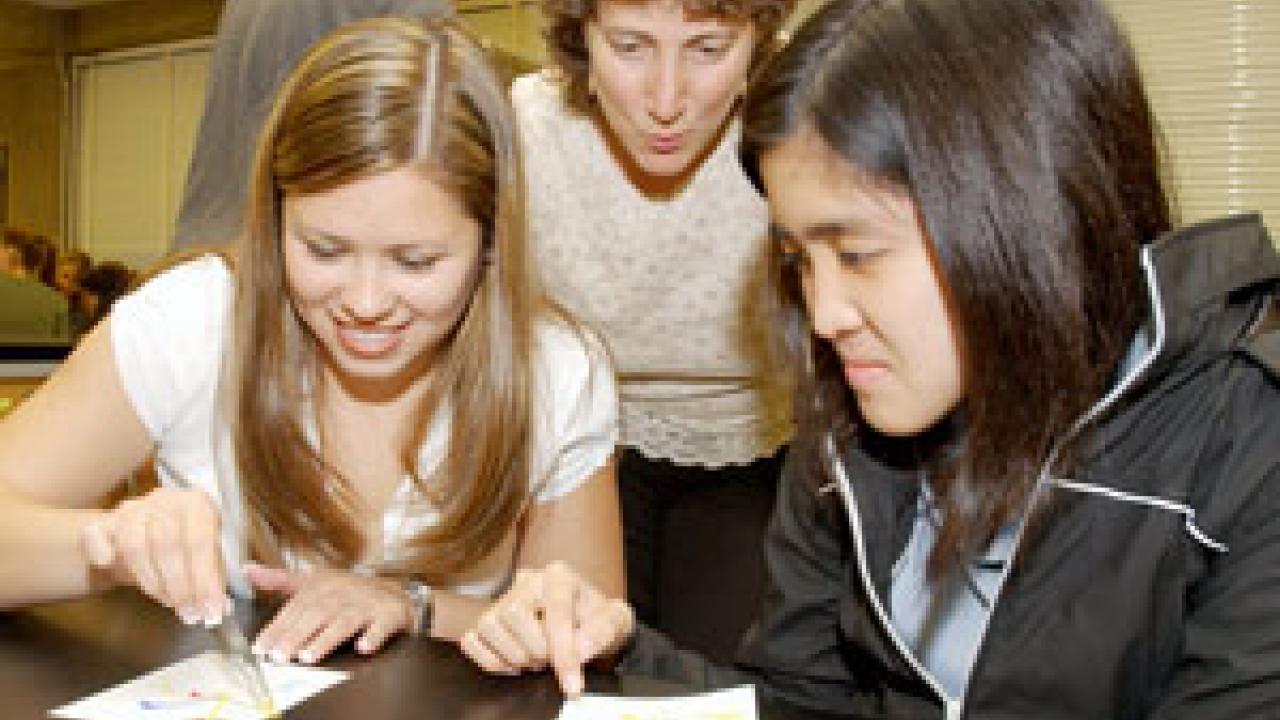When Diane Ullman's Entomology 1 class walked in the door Monday, they were not expecting to create art. And they were definitely not expecting to create that art with the help of squirming maggots.
Thanks to Rebecca Bullard, a graduate student in entomology, and Brandi Schmitt and Charlotte Wacker from the School of Medicine's Donated Body Program, the students got a taste of Maggot Art, an interactive outreach program that teaches about an insect tool used in forensics and medicine, and now, art.
Maggot Art, which is created by dipping one or more maggots in paint and then letting them loose on paper, was founded by Bullard in 2001 while working on her doctorate at the University of Hawaii. From her research on maggots, she knew the creatures trailed juices when crawling on meat, which led to her discovery.
"A fellow lab mate and I were hanging around after many, many hours of rearing maggots and we said, 'Hey, what would happen if we dipped them in paint?'" Bullard said. The result was a style of design often compared to the work of abstract artist Jackson Pollock.
Bullard said she initially had no intention of turning her discovery into an educational program. But when it came time for her entomology department to make a presentation at the annual Hawaii State Farm Fair, she decided to share Maggot Art with kids.
"People were getting bored just looking at dead bugs, so it was a pretty big success right off the bat," Bullard said.
Bullard, Schmitt and Wacker usually gear their program toward kindergarten-through-fourth-grade students. The young students were often already learning about life cycles, so learning about maggots was a logical addition to the curriculum. Besides, Schmitt added with a smile, "Kids love anything that's gross."
Bullard met Schmitt after moving to UC Davis last year to continue her graduate studies. "We just kind of clicked and became friends," Schmitt said. "For me it's dead bodies and for her it's maggots. We both study things most people consider gross."
Schmitt and Wacker volunteer time in area classrooms with Bullard, helping children dip maggots into non-toxic paint with forceps and release them onto construction paper. The process is harmless for the maggots, Bullard said, noting she has received numerous e-mails voicing concern for the maggots' well-being.
While the maggots work, Bullard and Schmitt take the opportunity to teach students how important maggots are in society.
Not only do the fly larvae help the environment by decomposing rotting material, but they have been applied to wounds for thousands of years and are still used on burn victims today as a safe way to remove dead tissue, Schmitt said. Forensic entomologists also study the maggots on a body to determine how long a corpse has been dead.
Bullard and Schmitt have their hands full with their work even without their commitment to Maggot Art. As curator of the Donated Body Program, Schmitt is responsible for supplying cadavers to a number of universities in northern California, participating in medical research and taking care of administrative duties.
Bullard is currently a consultant for the Sacramento County Coroner's Office and is doing research on forensic applications for maggots. She works out of the Bee Biology facilities near the UC Davis airport, and is currently rearing six species of maggots for her research. Ultimately she would like to become a professor. "I enjoy teaching," she said. "There's nothing else for me."
Despite their busy schedules both Bullard and Schmitt believe it's necessary to put their time and effort into Maggot Art outreach.
"It's important to educate kids on all animals whether they're disgusting or not," said Bullard. "Adults already have this aversion to maggots, but kids aren't naturally scared of anything. They're the perfect target audience."
Although college students might be a bit past the target age, the Maggot Art team's presentation to the Entomology 1 class made a favorable impression.
Comments included: "This is the most fun with maggots I've ever had!" and "Maggots seemed pretty disgusting before, but now they don't seem so bad."
Education is not the only motivation for continuing the program. Schmitt and Bullard also do it because they love Maggot Art and respect it as a form of expression. "A scientist can see the art in a lot of things," Schmitt said. "There's an artistic aspect to science and nature."
The two enthusiasts say Maggot Art is similar to other art forms. Artists develop a distinct style based on the color scheme they use, the areas they tend to place maggots on the paper and the number of maggots they like to use.
Bullard runs Maggot Art entirely in her free time and without outside funding. "It's 100 percent out of my own pocket," she said. "I'm definitely in the hole."
At some point, the maggot artists have aspirations of making some money out of their program. Shirts are already available on the Maggot Art Web site (http://www.maggotart.com) for between $14 and $18. There are also plans to sell prints of the artwork and to put together a teacher's workbook in the near future.
"It's not a high-profit generator, but it would be nice to break even," Schmitt said.
